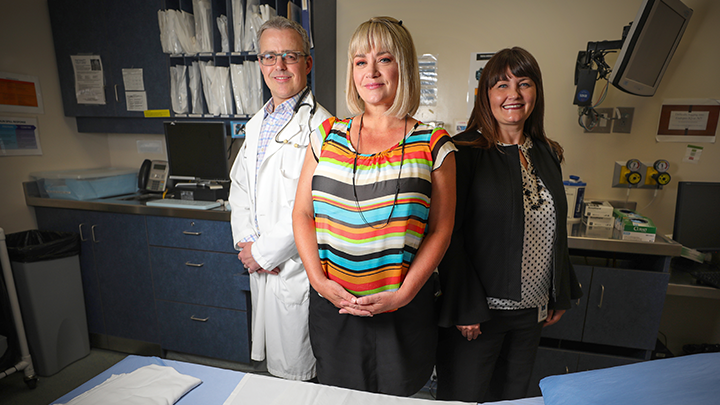
January 21, 2020

Dr. Steve Heitman and Carmen Oilund are working to improve endoscopy care for Albertans like Amy van Engelen, centre.
Story by Greg Harris | Photo by Leah Hennel
If Calgarian Amy van Engelen could improve one thing about the health system, it would be to make sure patients experience high-quality endoscopies — regardless of the clinic or doctor performing them.
In an endoscopy, a doctor inserts a flexible, lighted tube with a tiny camera into the digestive tract for an interior view.
Van Engelen has had more experience with them than she’d like. Her colitis, which is inflammation of the large intestine, requires regular monitoring by colonoscopy; doctors have also scoped her upper digestive tract several times.
“I’ve had many of these procedures that have been fine, but some of them have been very difficult,” she says. “I don’t look forward to them — you never know what you’re going to get and it surprises me that I’ve had such different experiences.”
The Digestive Health Strategic Clinical Network (DHSCN) and the Alberta Colorectal Cancer Screening Program (ACRCSP) are aiming to change that with a quality-improvement initiative focused on the endoscopy care that Albertans receive.
The goal is for all 50 sites in Alberta that provide endoscopies to identify areas for improvement and create action plans targeting specific quality improvement initiatives.
“Improving the quality of the endoscopy procedure as well as enhancing the quality of the patient experience are two key objectives of the initiative,” says Carmen Oilund, a Digestive Health Senior Practice Consultant with the DHSCN and coordinator of the improvement program.
Teams from each site are using a web-based evaluation tool called the Canada-Global Rating Scale (C-GRS) and then determining which of 12 different areas of endoscopy quality to focus on improving. It gives each clinic the flexibility to identify areas they may have scored low on and then develop a plan for improvement. Currently, 44 out of the 50 endoscopy sites in Alberta have completed the C-GRS survey.
In order to help support sites with this quality improvement work, the DHSCN and the ACRCSP hosted a C-GRS Innovation Learning Collaborative on Nov. 29, 2019, in Leduc. Teams from 37 endoscopy sites from across the province came together to learn a model for improvement that will enable them to identify, test and measure endoscopy quality-improvement ideas locally.
Dr. Steve Heitman, the Medical Director of the Forzani & MacPhail Colon Cancer Screening Centre (CCSC), says the CCSC has used the C-GRS for several years.
“C-GRS is really a platform for evaluating unit-level quality. It provides endoscopy units with a tool to monitor where they are at, and where they can get to. It will help elevate the entire service across the board and maintain more consistency,” Dr. Heitman says.
Over the years, the C-GRS has led CCSC to adjust how it handles pre-screening appointments, based on patient feedback. It has also tweaked how it provides information to family doctors and made physician report cards on the quality of the procedure a permanent feedback tool.
The CCSC, which performs more than 17,000 endoscopy screenings every year, has made improvements in 114 of 116 different areas identified in the C-GRS. Dr. Heitman says they’d have a perfect score but the final category is an infrastructure issue that is unfeasible for them to address.
“The C-GRS has been huge for us in improving the patient experience,” he adds. “It’s successful because it has simply become the way we operate — people here don’t even realize they’re engaged in an ongoing improvement process.”
The GRS was first introduced in 2004 in the United Kingdom and later adapted for use in Canada by the Canadian Association of Gastroenterology.
In Alberta, the goal is to have each site complete the C-GRS survey at least twice a year. Over time, the expectation is that the C-GRS will elevate quality of endoscopy care across the province and maintain more consistency in how services are provided.
“I think it’s fantastic that they hope to reach all 50 sites with this,” Van Engelen adds. “I think it will make a huge improvement.”